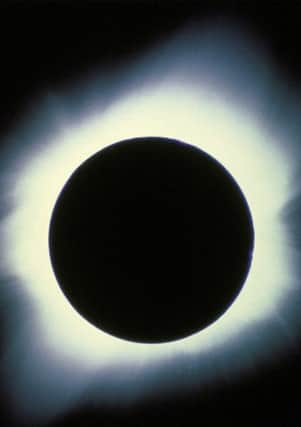Solar eclipse in Londonderry: Update


The eclipse will reach totality across the Arctic and in the far Northern regions of Europe.
It will be the last total solar eclipse in Europe for over a decade, with the next one not visible in Europe until 2026.
Advertisement
Hide AdAdvertisement
Hide AdNorthern Ireland and the UK will experience this as a deep partial eclipse, while the total eclipse will be seen on two remote groups of islands: the Faroe Islands and Svalbard.


The total phase of this solar eclipse is not visible in Londonderry, but it can be observed there as a partial solar eclipse.
The moon covers a large portion of the Sun, so this is still a spectacular sight.
Weather conditions in Londonderry are predicted to be fine for the event. Current forecasts state that conditions will be sunny but cloudy with a predicted temperature of 9 °C. Wind will come from a north westerly direction at a speed of around 8mph. Visibility will be at a range of 7km and there is only a five per cent chance of rain.
Advertisement
Hide AdAdvertisement
Hide AdIf you are planning to view the eclipse there are however safety guidelines that must be followed. The Sun’s UV radiation can burn the retinas in the eyes leading to permanent damage or even blindness. This can occur even if your eyes are exposed to direct sunlight for just a few seconds.
Some safe options:
Pinhole projector: An easy and cheap way to view the Sun is to project its image to a screen, such as a sheet of white paper or cardboard. Projection works well with or without a telescope or binoculars. However, don’t look through the telescope’s eyepiece or side-mounted finder scope while projecting the Sun’s image to a screen.
Eclipse glasses: If you are not the D.I.Y. type, check in with your local natural history or space museum or your local astronomy club for where to rent or buy eclipse glasses.
Welder’s goggles: NASA recommends welder’s glasses rated 14 or higher. These can be found at your local welding supply store. Keep in mind that welder glass grading may be different in different countries.
Advertisement
Hide AdAdvertisement
Hide AdAluminized Mylar sheeting: Mylar can be easily cut with scissors but make sure that the sheets you use are aluminized and that you take the advice of experts while using it.
You can use special solar filters to see the Sun during a solar eclipse, but use the proper type of solar filter that is designed for eclipses. Check that filters do not crack under the Sun’s magnified and focused intensity. Solar filters must be treated with care or they can quickly become damaged and unsafe to use.
How not to view a solar eclipse
It goes without saying that you should never look directly at the Sun without any protective eyewear before, after or during a solar eclipse.
According to NASA, the following materials should never be used to view a solar eclipse:
Colour film.
Medical X-ray film with images on them.
Smoked glass.
Any kind of sunglasses.
CDs or floppy disks.
Advertisement
Hide AdAdvertisement
Hide AdThe bottom line is, do not take any chances. If you are unsure about the safety of a viewing device, talk to an expert first before using it.
13 fascinating facts about the solar eclipse
Most of the sun will be blocked out by a solar eclipse on Friday. Here’s our take on the event.
1. Up to 87 per cent of the sun will be covered in the Portsmouth area as the moon passes in front of it on Friday morning.
2. The incredible spectacle begins at around 8.22am, reaches its maximum extent at 9.29am, and ends at 10.39am.
Advertisement
Hide AdAdvertisement
Hide Ad3. In Vietnam, people seeing an eclipse believed that a giant frog was devouring the Sun, while in ancient China a hungry celestial dragon was thought to be responsible.
4. According to ancient Hindu mythology, the demon Rahu is beheaded by the supreme deity Vishnu for drinking the nectar of the gods. His head flies across the sky and swallows the Sun.
5. It was common practice for people to bang pots and pans and make loud noises during a eclipse to scare the demon away.
6. Korean folklore tells of the Sun being stolen by mythical dogs, while in Europe, the Vikings blamed wolves for consuming the Sun.
Advertisement
Hide AdAdvertisement
Hide Ad7. The ancient Greeks believed a solar eclipse was a sign that the gods were angry, and that it heralded disasters and destruction.
8. Among modern superstitions is the belief that solar eclipses can be a danger to pregnant women and unborn children. In some cultures, young children and expectant mothers are asked to stay indoors during an eclipse.
9. In parts of India, people still fast during a solar eclipse because of the fear that any food cooked during the event will be poisoned.
10. A few superstitions offer a positive slant on eclipses. In Italy some believe that flowers planted during a solar eclipse will be brighter and more colourful than at any other time.
Advertisement
Hide AdAdvertisement
Hide Ad11. The Batammaliba people from Benin and Togo in West Africa have a legend that during an eclipse the Sun and Moon are fighting. The only way to stop the conflict, they believe, is for people on Earth to settle their differences.
12. The last solar eclipse of such significance occurred on August 11 1999, and was “total” - with 100% of the Sun covered - when seen from Cornwall
13. The next total eclipse is not until September 2090
Conditions for viewing the solar eclipse in Derry